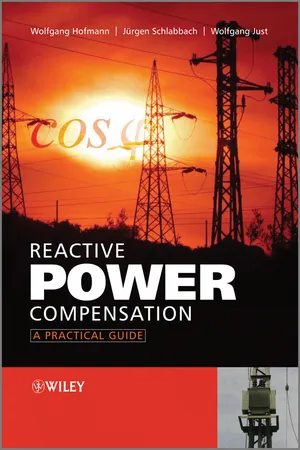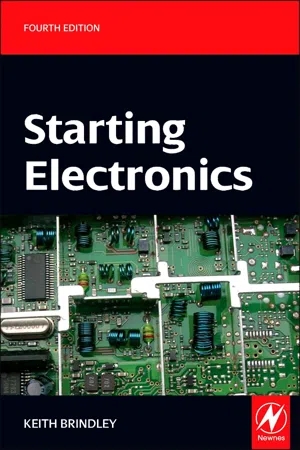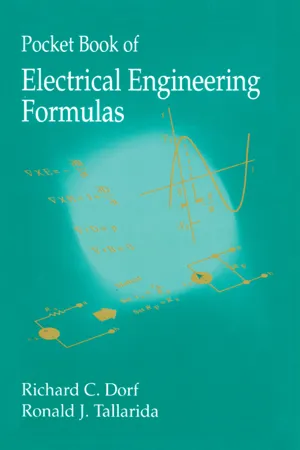Capacitors in Series and Parallel
When capacitors are connected in series, their total capacitance decreases, and the voltage across each capacitor is the same. In contrast, when capacitors are connected in parallel, their total capacitance increases, and the voltage across each capacitor is also the same. These configurations are important in understanding the behavior of capacitors in electronic circuits.
8 Key excerpts on "Capacitors in Series and Parallel"
- eBook - ePub
Measurement, Instrumentation, and Sensors Handbook
Electromagnetic, Optical, Radiation, Chemical, and Biomedical Measurement
- John G. Webster, Halit Eren, John G. Webster, Halit Eren(Authors)
- 2017(Publication Date)
- CRC Press(Publisher)
...The power, voltage, and current relationships in a capacitor are given in Figure 28.11c. 28.5.1 Series and Parallel Connections The formulae for series and parallel connection of capacitors can be obtained from the impedances of such connections as shown in Figure 28.12a and b. For the series connection, the impedances are added such that 1 s C = 1 s C 1 + 1 s C 2 + ⋯ + 1 s C n (28.20) where C 1, C 2, …, C n are the capacitance of the capacitors connected in series. Thus, the equivalent value of the capacitances in series connection can be expressed by C = { 1 C 1 + 1 C 2 + ⋯ + 1 C n } - 1 (28.21) The final capacitance value will always be smaller than the smallest value. In a similar way, the equivalent capacitance of parallel connections can be expressed. as C = C 1 + C 2 + ⋯ + C n (28.22) and the final value of C is always larger than the largest capacitance in the circuit. FIGURE 28.12 Series and parallel connection of capacitors: (a) series connection and (b) parallel connection. In the series connection, the final capacitance value will always be smaller than the smallest value of the capacitor in the circuit, whereas in parallel connection, the final value is greater than the largest capacitance. 28.5.2 Distributed Capacitance Circuits Capacitance is inherent whenever an electric potential exists between two conducting bodies, albeit in electric circuits, communication equipment, electronic circuit boards, computer devices, and so on. For example in electric circuits, its effect will be most noticeable in the coils and in the transmission lines. In the case of coils, there are small capacitances between adjacent turns, between turns that are not adjacent, between terminal leads, between turns and ground, etc. Each of the various capacitances associated with the coil stores a quantity of electrostatic energy that is determined by the capacitance involved and the fraction of the total coil voltage that appears across it...
- eBook - ePub
Reactive Power Compensation
A Practical Guide
- Wolfgang Hofmann, Jürgen Schlabbach, Wolfgang Just(Authors)
- 2012(Publication Date)
- Wiley(Publisher)
...In ready-assembled banks the capacitors are connected in parallel to achieve the required reactive power for individual compensation tasks. In general the mounting of capacitor banks is simple and economical. Any extension is possible any time. Serial connection of capacitors is very rarely used in LV capacitors but much more in MV capacitors (see Section 7.6). 7.5.1 Capacitors Connected in Parallel Parallel connection of capacitors increases the total capacitance accordingly. The total capacitance is equal to the sum of all the capacitors (Figure 7.5). The rated voltage of each capacitor has to comply with the grid voltage, including at least some tolerance (see Section 7.2). Thus Figure 7.5 Capacitors connected in parallel. (7.9) (7.10) (7.11) (7.12) (7.13) 7.5.2 Capacitors Connected in Series As mentioned above, it is sometimes necessary to assemble capacitors in serial connection at MV capacitors in order to reduce the voltage for each capacitor element. However, series connection does not increase the total capacitance C t but is reduced due to the series connection of the dielectrics. It is just like increasing the distance of the electrodes in a plate-type capacitor. The voltage for each capacitor, if their capacitances are equal, is divided by the sum of the elements (Figure 7.6). However, if their capacitances are not equal the partial voltage of each capacitor is described mathematically by (7.14) (7.15) (7.16) (7.17) 7.5.3 Star and Delta Connection of Power Capacitors Power capacitors for applications in three-phase systems are delivered either in star or in delta connection from the factory. On request and for special applications three-phase capacitors are available without any connections, just with six terminals for connecting as required...
- eBook - ePub
- W. Bolton(Author)
- 2015(Publication Date)
- Routledge(Publisher)
...Because they are in parallel, the potential difference V across each capacitor will be the same. The charges on each capacitor will depend on their capacitances. If the total charge shared between the capacitors is Q, then: Q = Q 1 + Q 2 + Q 3 Dividing throughout by V gives: But C 1 = Q 1 / V, C 2 = Q 2 /V and C 3 = Q 3 / V. Hence, if we replaced the three parallel-connected capacitors by a single equivalent capacitor with a capacitance given by C = Q/V, we must have: C = C 1 + C 2 + C 3 The equivalent capacitance of parallel-connected capacitors is the sum of their individual capacitances. Example What is the capacitance of a 2 μF capacitor and 4 μF capacitor when connected in parallel? C = 2 + 4 = 6 μF 13.4 Parallel plate capacitor The capacitance of a pair of parallel conducting plates depends on the plate area A, the separation d of the plates and the medium, i.e. the dielectric, between the plates. To see how these factors determine the capacitance, consider the effect of doubling the area of the plates as being effectively the combining of two unit area capacitors in parallel (Figure 13.6(a)). For two identical capacitors in parallel, the total capacitance is the sum of the individual capacitances and so the capacitance is doubled. Thus doubling the area doubles the capacitance. The capacitance is proportional to the area A : C α A Figure 13.6 (a) Capacitors in parallel and equivalent capacitor, (b) capacitors in series and equivalent capacitor Now consider the effect of doubling the separation of the plates. This can be thought of as combining two identical capacitors in series (Figure 13.6(b)). The reciprocal of the total capacitance is then 2/ C and so the capacitance is halved by doubling the separation...
- Magno Urbano(Author)
- 2019(Publication Date)
- Wiley(Publisher)
...Characteristics These are the main characteristics of capacitors: They store electric charges in the form of an electric field. An ideal capacitor can store an electric charge indefinitely. In real life, they discharge slowly through the dielectric (leakage), because dielectrics are not perfect insulators and let a little bit of current flow. Capacitors block direct current. Capacitors let alternating current (AC) pass. Like resistors, capacitors are passive components, because they do not have an active role inside a circuit. 8.5 Electric Field Considering that the plates of a capacitor have an area equal to A and are separated by a distance d, the electric field between the plates can be found by using the following equation. ELECTRIC FIELD E is the electric field, in Newtons per Coulomb or volts per meter. q is the amount of stored charge, in Coulombs. ε is the dielectric permittivity, in Farads per meter (F/m). A is the plate area, in squared meters. d is the distance between the plates, in meters. 8.6 Capacitance Capacitance is the ratio of the change in an electric charge in a system to the corresponding change in its electric potential. CAPACITANCE C is the capacitance, in Farads. q is the amount of charge, in Coulombs. V is the electric potential, in Volts. Capacitance is measured in Farads 3 and represented by the uppercase letter F in the SI. According to this formula, a capacitor of 1 F can store a charge of 1 C when subjected to 1 V. There are two kinds of capacitance: one produced by the object itself and one produced by proximity to other objects. Any object that. can be electrically charged will have its own value of capacitance. Also, any object in the proximity of others will generate mutual capacitance. Every component in a circuit has capacitance...
- eBook - ePub
- Keith Brindley(Author)
- 2011(Publication Date)
- Newnes(Publisher)
...Increasing the capacitance, say, increases the charge stored. As the current flowing is determined by the resistance in the circuit, and is thus fixed at any particular voltage, this increased charge takes longer to build up or longer to decay away. Reducing the capacitance reduces the charge, which is therefore more quickly stored or more quickly discharged. Similarly, as the resistor in the circuit defines the current flowing to charge or discharge the capacitor, increasing or decreasing its value must decrease or increase the current, therefore increasing or decreasing the time taken to charge or discharge the capacitor. This is why the circuit’s time constant is a product of both capacitance and resistance values. Capacitance Values Finally, we can look at how the size and construction of capacitors affects their capacitance. The capacitance of a basic capacitor, for example, consisting of two parallel, flat plates separated by a dielectric, may be calculated from the formula: where ε is the permittivity of the dielectric, A is the area of overlap of the plates, and d is the distance between the plates. Different insulating materials have different permittivities, so different capacitor values may be made, simply by using different dielectrics. Air, say, has a permittivity of about 9×10 −12 farads per meter (that is, 9×10 −12 F m −1). Permittivities of other materials are usually expressed as a relative permittivity, where a material’s relative permittivity is the number of times its permittivity is greater than air...
- eBook - ePub
- Adrian Waygood(Author)
- 2018(Publication Date)
- Routledge(Publisher)
...capacitors: Q = Q 1 + Q 2 + Q 3 —(equation 9) Since charge is the produce of capacitance and voltage, we can rewrite equation (9) as follows: CE = C 1 U+C 2 U+C 3 U Since the supply voltage is common to each branch of a parallel circuit, we can now divide throughout by voltage: C E⃥ E⃥ = C 1 U U + C 2 U U + C 3 U U c = c 1 + c 2 + c 3 To summarise for a parallel circuit: I = I 1+ I 2 +I 3 Q =. Q 1 + Q 2 + Q 3 C = C 1 + C 2 + C 3 Worked example 8 Three capacitors, of 25 μF, 50 μF and 75 μF, are connected in parallel across a 100-V D.C. supply. Calculate each of the following: the circuit’s total capacitance the charge on each capacitor the voltage drop across each capacitor the energy stored on capacitor C 1. Solution As always, you should start by sketching the circuit (see Figure 22.37), and inserting all the values given in the question. Figure 22.37 C = C 1 + C 2 + C 3 = 25+50+75 = 150 μF (Answer a.) Q q =CU= 150xl0 -6 1l00=15000X10 -6 = 15 mC (Answer b.) 1x = 1 U / = 25x0 -_ 100O = 2.5 mC 2 = c 2 U = 50 l 2 0" 6 C x l OO = 5.0 -m 100 c 2 U = 50xl0" 6 xlOO = 5 Q 0 mC (A nswer. c. -4 0 3 = C 3 U = 75xl0~ s xl00 = 7.5 mC (Answer c.3) check your answer: (Q 1 + Q 2 + Q 3 =2.5+5.0+7.5=15.0 mC) W = 1 2 C 1 U 2 = 1 2 × 2 5 × 1 0 - 6 × 1 0 0 2 = 1 2 5 m J (A n s w e r) Capacitors in series-parallel We resolve series-parallel capacitive circuits in much the same way we learnt to logically solve resistors in series-parallel. By way of example, let’s solve the series-parallel circuit shown in Figure 22.38. Figure 22.38 We start by finding the equivalent capacitance of the two capacitors, C 1 and C 2 that are connected in parallel, which we’ll label C A : C A = C 1 +C 2 = 100+200 = 300 pF This leaves C A and C 3 in series, from which we can find the equivalent capacitance of the complete...
- eBook - ePub
- Christopher Kitcher(Author)
- 2022(Publication Date)
- Routledge(Publisher)
...supply, (a) in series and (b) in parallel. For each case, calculate the resultant capacitance and also the potential difference across each capacitor. A 12μF capacitor is charged to 25V. The energy stored is 150μJ 3750μJ 3750J 150J Capacitors of 2μF and 4μF are connected in series. When an additional capacitor is connected in series, the combined capacitance falls to 1μF The value of the third capacitor is 4μF 0.5μF 0.25μF 1.2μF Capacitors of 8μF, 12μF and 20μF are connected in parallel. For a total charge of 4000μC to be stored, the voltage to be applied to the combination is 0.01V 15 480V 100V 1034V...
- eBook - ePub
- Richard C. Dorf, Ronald J. Tallarida(Authors)
- 2018(Publication Date)
- CRC Press(Publisher)
...15 Circuits with Energy Storage Elements 1. Capacitors Capacitance is a measure of the ability of a device to store energy in the form of separated charge or in the form of an electric field: q = C υ where q is the charge, υ is the voltage across the element, and C is the capacitance measured in farads (F). The current through a capacitor is i = C d υ d t The voltage across a capacitor C is υ = 1 C ∫ t 0 t i d τ + υ (t 0) where υ (t 0) is the voltage at t 0. 2. Inductors Inductance is a measure of the ability of a device to store energy in the form of a magnetic field. The voltage across an inductor is υ = L d i d t where i is the current through the inductor and L is the inductance measured in henrys (H). The current in an inductor is i = 1 L ∫ t 0 t υ d τ + i (t 0) 3. Energy Stored in Inductors and Capacitors ω = 1 2 C υ 2 and ω = 1 2 L i 2 4. Series and Parallel Inductors A series connection of N inductors can be represented by one series equivalent inductor L s as L s = ∑ n = 1 N L n A parallel connection of N inductors can be represented by one equivalent. inductor L p as 1 L p = ∑ n = 1 N 1 L n 5. Series and Parallel Capacitors The equivalent capacitance of a set of N parallel capacitors is simply the sum of the individual capacitances: C p = ∑ n = 1 N C n A series connection of N capacitors can be represented by one equivalent capacitance C s : 1 C s = ∑ n = 1 N 1 C n 6. The Natural Response of an RL or RC Circuit The natural response of a circuit depends only on the internal energy storage of the circuit and not on external sources...







